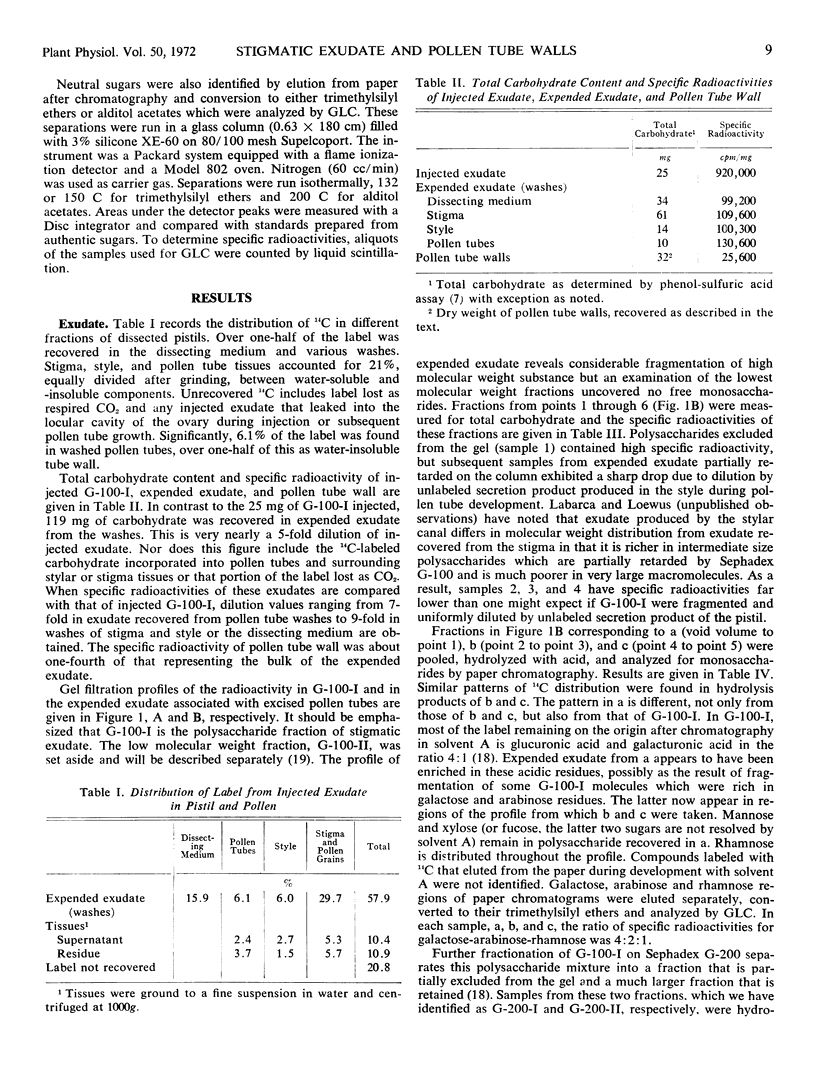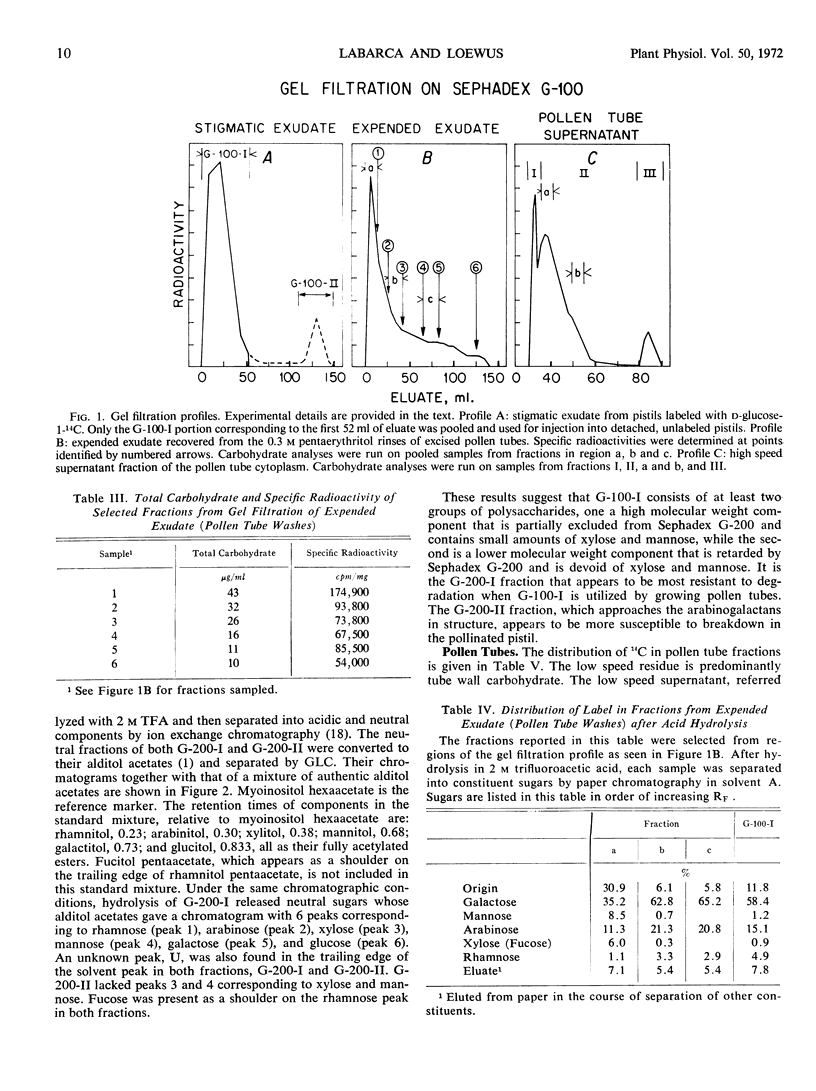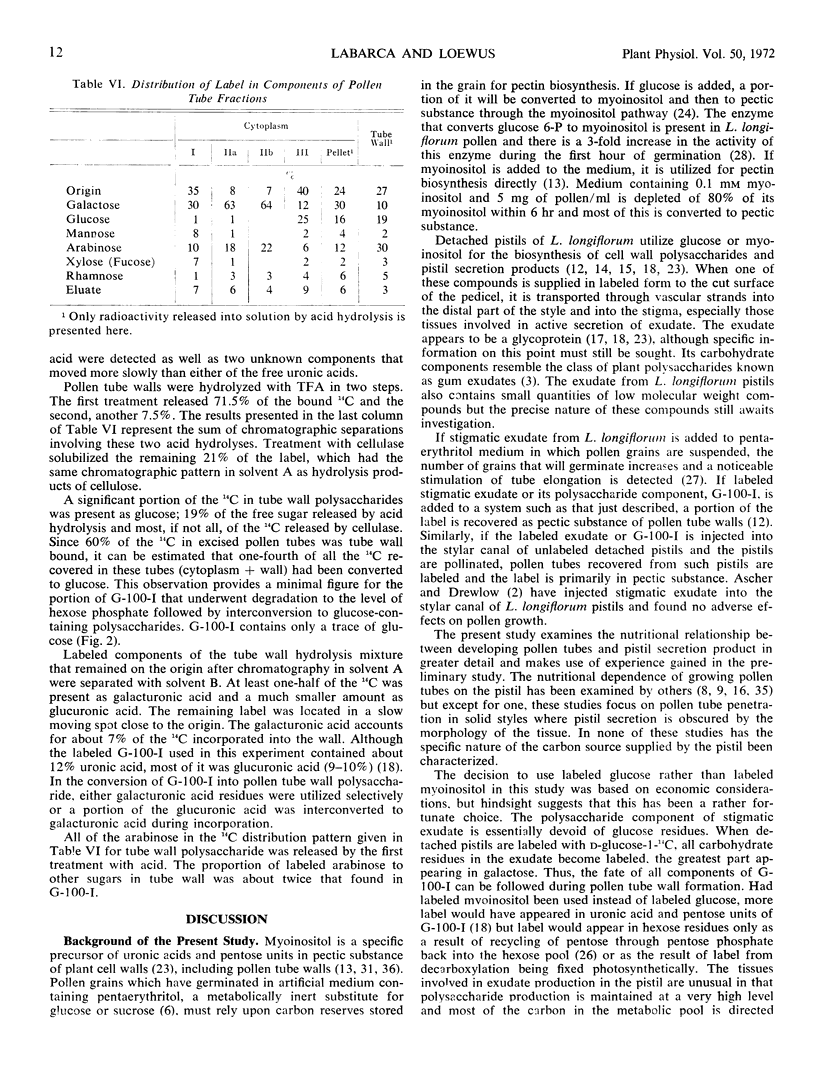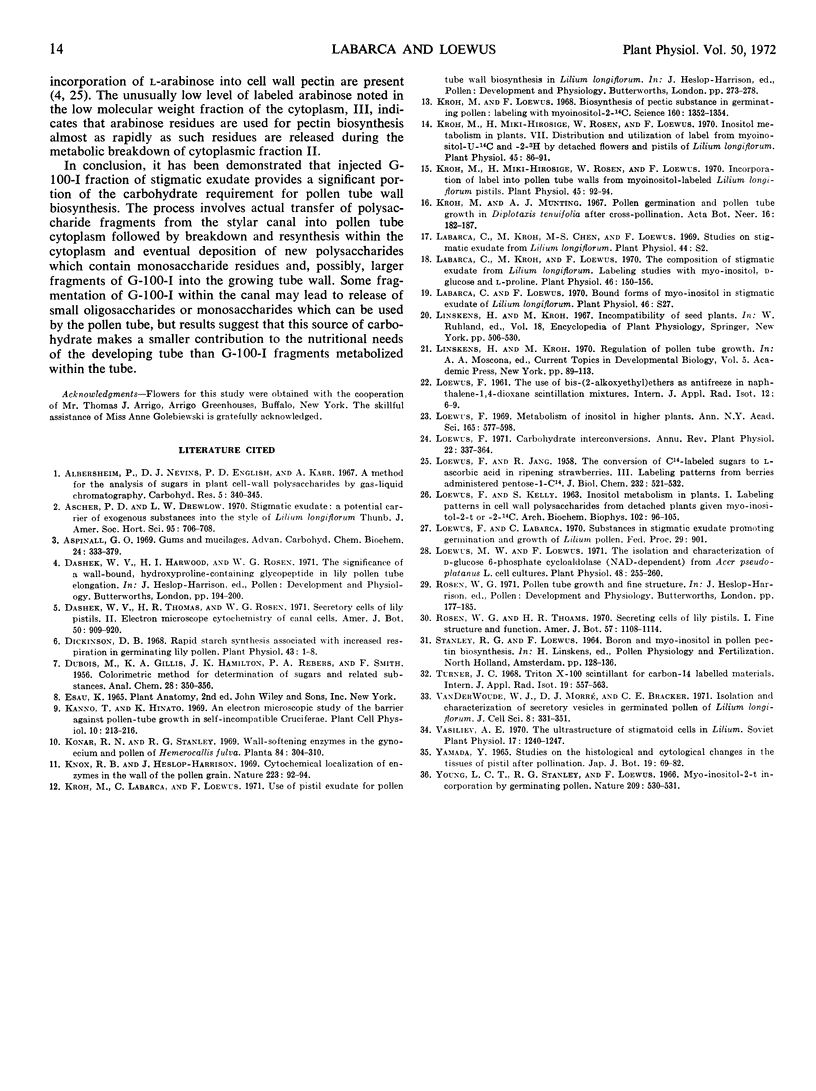Abstract
A quantity of labeled stigmatic exudate, collected from detached Lilium longiflorum (cv. Ace) pistils labeled with d-glucose-1-14C, was fractionated on Sephadex G-100 and the polysaccharide component, G-100-I, was injected into the hollow styles of unlabeled detached pistils (cv. Ace) which had been removed on the day after anthesis from the plant. Injected pistils were immediately cross-pollinated with L. longiflorum (cv. No. 44) pollen. Eighty-four hours later, pistils were dissected to recover the pollen tubes, expended exudate, and labeled tissues of the stigma and style. Distribution of label revealed that at least 25% of the carbohydrate substance in excised pollen tubes was derived from G-100-I. The composition of expended exudate adhering to pollen tubes, of pollen tube cytoplasm, and of pollen tube walls suggests that utilization of exudate by growing pollen tubes involves uptake and incorporation into pollen tube cytoplasm of exudate polysaccharide fragments followed by extensive metabolism of at least a portion of the incorporated carbohydrate prior to its utilization for pollen tube wall biosynthesis. Results suggest the presence of at least two polysaccharide components in G-100-I, one which resists major degradation following injection into the style and another which undergoes measurable degradation both before and after entry into the pollen tube.
Full text
PDF







Selected References
These references are in PubMed. This may not be the complete list of references from this article.
- Aspinall G. O. Gums and mucilages. Adv Carbohydr Chem Biochem. 1969;24:333–379. doi: 10.1016/s0065-2318(08)60353-4. [DOI] [PubMed] [Google Scholar]
- Dickinson D. B. Rapid starch synthesis associated with increased respiration in germinating lily pollen. Plant Physiol. 1968 Jan;43(1):1–8. doi: 10.1104/pp.43.1.1. [DOI] [PMC free article] [PubMed] [Google Scholar]
- Hubbert W. T., Rosen M. N. Pasteurella multocida Infections: I. Pasteurella Multocida Infection Due to Animal Bite. Am J Public Health Nations Health. 1970 Jun;60(6):1103–1108. doi: 10.2105/ajph.60.6.1103. [DOI] [PMC free article] [PubMed] [Google Scholar]
- Kroh M., Loewus F. Biosynthesis of pectic substance in germinating pollen: labeling with myoinositol-2-14C. Science. 1968 Jun 21;160(3834):1352–1354. doi: 10.1126/science.160.3834.1352. [DOI] [PubMed] [Google Scholar]
- Kroh M., Miki-Hirosige H., Rosen W., Loewus F. Incorporation of label into pollen tube walls from myoinositol-labeled Lilium longiflorum pistils. Plant Physiol. 1970 Jan;45(1):92–94. doi: 10.1104/pp.45.1.92. [DOI] [PMC free article] [PubMed] [Google Scholar]
- Kroh M., Miki-Hirosige H., Rosen W., Loewus F. Inositol metabolism in plants. VII. Distribution and utilization of label from myoinositol-U 14C and -2-3H by detached flowers and pistils of Lilium longiflorum. Plant Physiol. 1970 Jan;45(1):86–91. doi: 10.1104/pp.45.1.86. [DOI] [PMC free article] [PubMed] [Google Scholar]
- LOEWUS F. A., JANG R. The conversion of C14-labeled sugars to L-ascorbic acid in ripening strawberries. III. Labeling patterns from berries administered pentose-1-C14. J Biol Chem. 1958 May;232(1):521–532. [PubMed] [Google Scholar]
- Labarca C., Kroh M., Loewus F. The Composition of Stigmatic Exudate from Lilium longiflorum: Labeling Studies with Myo-inositol, d-Glucose, and l-Proline. Plant Physiol. 1970 Jul;46(1):150–156. doi: 10.1104/pp.46.1.150. [DOI] [PMC free article] [PubMed] [Google Scholar]
- Loewus F. Metabolism of inositol in higher plants. Ann N Y Acad Sci. 1969 Oct 17;165(2):577–598. [PubMed] [Google Scholar]
- Loewus M. W., Loewus F. The Isolation and Characterization of d-Glucose 6-Phosphate Cycloaldolase (NAD-Dependent) from Acer pseudoplatanus L. Cell Cultures: Its Occurrence in Plants. Plant Physiol. 1971 Sep;48(3):255–260. doi: 10.1104/pp.48.3.255. [DOI] [PMC free article] [PubMed] [Google Scholar]
- Quinlan J. D., Weaver R. J. Modification of Pattern of Photosynthate Movement within and between Shoots of Vitis vinifera L. Plant Physiol. 1970 Oct;46(4):527–530. doi: 10.1104/pp.46.4.527. [DOI] [PMC free article] [PubMed] [Google Scholar]
- Turner J. C. Triton X-100 scintillant for carbon-14 labelled materials. Int J Appl Radiat Isot. 1968 Jul;19(7):557–563. doi: 10.1016/0020-708x(68)90065-3. [DOI] [PubMed] [Google Scholar]
- VanDerWoude W. J., Morré D. J., Bracker C. E. Isolation and characterization of secretory vesicles in germinated pollen of Lilium longiflorum. J Cell Sci. 1971 Mar;8(2):331–351. doi: 10.1242/jcs.8.2.331. [DOI] [PubMed] [Google Scholar]


